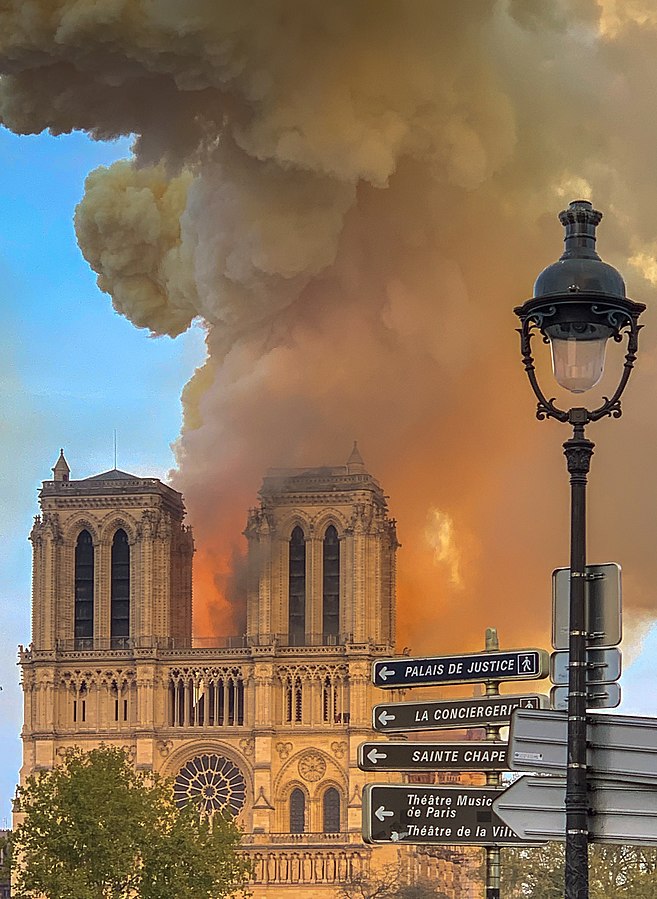Image: Photo of Notre Dame in flames. Image Credit: Wikipedia, Millipede, no changes made to image.
Last week the world watched in shock as Notre Dame, a building that has stood as a sentinel over hundreds of years of French history, burned. Images of the roof in flames scorched across news stations and social media around the world. When the smoke cleared and the ashes cooled, details on the extent of the damage began to emerge from the haze. As the footage of the fire suggested, the wooden roof and spire are destroyed. Additionally, roughly 5%-10% of the artwork in the building will be considered a loss.
Sadly, Notre Dame is not the first significant cultural institution ravaged by fire recently. In September 2018 the National Museum of Brazil was gutted by flames, and in March 2019 St. Louis’s Karpeles Manuscript Museum and Library lost most of their second floor to fire. Although less publicized, many locally significant places of cultural influence, such as churches, libraries, and opera houses have also fallen victim to fires caused by arson, war, and accident.
While the physical and psychological devastation of these events is difficult to fathom and must not be trivialized, technological projects carried out at many of these historical locations and museums provide a ray of hope that what is physically gone may not be truly lost forever.
Over the years Notre Dame has opened its doors to scholars seeking to utilize the latest technology to study and uncover the minute details in the building and to entertainment companies looking to incorporate the iconic building into their stories. For example, the late Dr. Andrew Tallon utilized a Leica Geosystems laser scanner to create digital 3D structures of the building. His work includes a billion data points collected over 50 scans. This data will likely prove invaluable to the Notre Dame’s restoration.
Photo: Image of Notre Dame from Assassin’s Creed: Unity (c) Ubisoft
https://news.ubisoft.com/en-us/article/348227/supporting-notre-dame-de-paris
The cathedral also played a starring role in the 2014 video game Assassin’s Creed: Unity. The game features highly detailed animations of the structure. Video game developers spent approximately two years painstakingly capturing and digitally recreating the minute facets of Notre Dame. Ubisoft, the developers of Assassin’s’ Creed, have pledged €500,000 toward the building’s restoration efforts, and is offering Assassin’s Creed: Unity for free through April 25. It is unclear at the moment if the full digital data will be offered to aid with the restoration work, but it seams reasonably likely.
These digital tools will be immensely helpful in restoring Notre Dame, but for institutions that do not have scholars and video game designers actively piloting the latest technology in digital capturing in their institutions, the question remains, what can organizations to do mitigate cultural loss in the event of a catastrophe?
For any institution, step one is to investigate state and federal legal requirements, as well as industry best practices, for fire codes, collections management and storage recommendations, and disaster preparedness rules and advice. The National Archives has extensive information available on fire prevention in cultural institutions.
Beyond this, many institutions have begun digitizing their collections, and these files can help mitigate the devastating loss that a fire or other disaster can cause. Technological advances in scanning and 3D printing now allow for works to be scanned and reproduced, physically or digitally, with incredibly fine detail and texture. As VR develops, museums and cultural heritage locations may find that these digitized user experiences provide a way to preserve the availability of the collection and structures should the physical location or items be lost from a catastrophic event.
The scope of the damage caused by the Notre Dame fire, both physically and psychologically, is difficult to wrap one’s head around. Yet it seems that thanks to the data collected by scholars and gaming companies Notre Dame will rise again from the ashes, and the bells will toll its resurrection.



